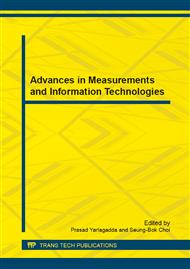[1]
Jinshu Su, Bofeng Zhang, Xin Xu, in: Advances in machine learning based text categorization, edited by Journal of Software, Vol. 17 (2006), pp.1848-1859.
Google Scholar
[2]
Xiaobing Xue, Zhihua Zhou, in: Distributional Features for Text Categorization, edited by IEEE Transactions on Knowledge and Data Engineering, Vol. 21 (2008), pp.428-442.
DOI: 10.1109/tkde.2008.166
Google Scholar
[3]
Wai Lam, Miguel Ruiz, Padmini Srinivasan, in: Automatic text categorization and its application to text retrieval, edited by IEEE Transactions on Knowledge and Data Engineering, Vol. 11 (1999), pp.865-879.
DOI: 10.1109/69.824599
Google Scholar
[4]
Setu Madhavi Namburu, Haiying Tu, Jianhui Luo and Krishna R. Pattipati, in: Experiments on Supervised Learning Algorithms for Text Categorization, edited by Proceedings of IEEE Aerospace Conference, (2005), pp.1-8.
DOI: 10.1109/aero.2005.1559612
Google Scholar
[5]
Kanoksri Sarinnapakorn, Miroslav Kubat, in: Combining Subclassifiers in Text Categorization: A DST-Based Solution and a Case Study, edited by IEEE Transactions on Knowledge and Data Engineering, Vol. 19 (2007), pp.1638-1651.
DOI: 10.1109/tkde.2007.190663
Google Scholar
[6]
Gabriel Pui Cheong Fung, Jeffrey X. Yu, Hongjun Lu, Philip S. Yu, in: Text classification without negative examples revisit, edited by IEEE Transactions on Knowledge and Data Engineering, Vol. 18 (2006), pp.6-20.
DOI: 10.1109/tkde.2006.16
Google Scholar
[7]
Frank Klawonn, Plamen Angelov, in: Evolving Extended Naive Bayes Classifiers, edited by Proceedings of Sixth IEEE International Conference on Data Mining, (2006), pp.643-647.
DOI: 10.1109/icdmw.2006.74
Google Scholar
[8]
Juan Sun, Xizhao Wang, in: An initial comparison on noise resisting between crisp and fuzzy decision trees, edited by Proceedings of Fourth International Conference on Machine Learning and Cybernetics, Vol. 4 (2005), pp.2545-2550.
DOI: 10.1109/icmlc.2005.1527372
Google Scholar
[9]
Quinlan J. R, in: Induction of Decision Trees, edited by Machine Learning, Vol. 1 (1986), pp.81-106.
Google Scholar
[10]
Houda Benbrabim, Amine Bensaid, in: A Comparative Study of Pruned Decision tree and fuzzy decision trees, edited by Proceedings of 19th Conference of the North American, (2000), pp.227-230.
DOI: 10.1109/nafips.2000.877426
Google Scholar


